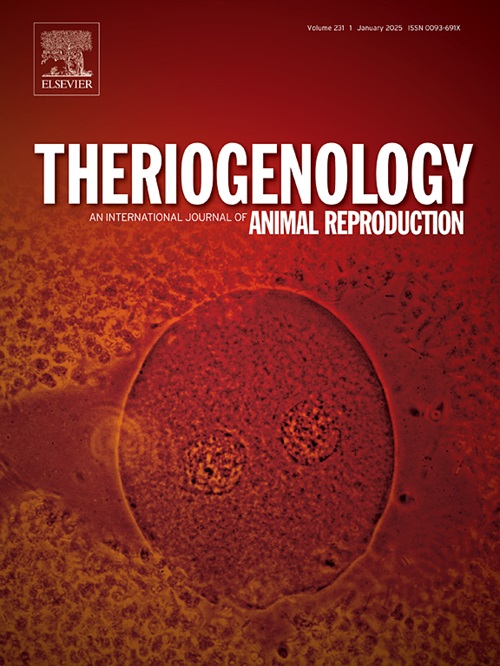Characterization of decellularized porcine oviduct- and uterine-derived scaffolds evaluated by spermatozoa-based biocompatibility and biotoxicity
IF 2.4
2区 农林科学
Q3 REPRODUCTIVE BIOLOGY
引用次数: 0
Abstract
Decellularized extracellular matrix (dECM) are widely utilized in regenerative medicine and tissue engineering due to their ability to promote cell growth, proliferation, and differentiation. In reproduction, research is focused on the utilization of these scaffolds to treat pathologies causing reproductive dysfunction or to improve assisted reproduction technologies (ARTs). We developed an efficient protocol employing the immersion-agitation technique to decellularize porcine oviductal and uterine sections, comparing the efficacy of fresh versus frozen treatments. Both methods successfully generated acellular matrices with less than 3 % residual DNA, effectively preserving structural and protein integrity. Scanning and transmission electron microscopy confirmed the ultrastructural integrity, whereas Masson's Trichrome staining highlighted better collagen preservation in frozen treatments. Proteomic analysis of decellularized scaffolds revealed collagen and key macromolecules such as laminin, filamin, dermatopontin, and fibronectin, which are essential for extracellular matrix structure and cell functions such as adhesion and migration. Innovatively, we assessed the biocompatibility and cytotoxicity of the scaffolds using spermatozoa, demonstrating that thorough washing ensures the scaffold biocompatibility without compromising sperm viability or motility. Our findings not only contribute to the standardization of decellularization protocols for female reproductive organs but also emphasize the importance of evaluating sperm biocompatibility to ensure the safety of dECM scaffolds.
基于精子的生物相容性和生物毒性评估猪输卵管和子宫脱细胞支架的特性
脱细胞细胞外基质(decellularized extracellular matrix,dECM)具有促进细胞生长、增殖和分化的能力,因此被广泛应用于再生医学和组织工程学领域。在生殖领域,研究重点是利用这些支架治疗导致生殖功能障碍的病症或改进辅助生殖技术(ART)。我们开发了一种高效的方案,采用浸泡-搅拌技术对猪输卵管和子宫切片进行脱细胞处理,并比较了新鲜处理和冷冻处理的效果。这两种方法都成功地生成了无细胞基质,其DNA残留量低于3%,有效地保持了结构和蛋白质的完整性。扫描和透射电子显微镜证实了超微结构的完整性,而马森氏三色染色法则强调了冷冻处理中胶原蛋白保存得更好。脱细胞支架的蛋白质组分析显示,胶原蛋白和关键大分子,如层粘连蛋白、丝胶蛋白、皮促蛋白和纤连蛋白,对细胞外基质结构和细胞功能(如粘附和迁移)至关重要。我们采用创新方法,利用精子评估了支架的生物相容性和细胞毒性,结果表明彻底清洗可确保支架的生物相容性,而不会影响精子的存活率或活力。我们的研究结果不仅有助于女性生殖器官脱细胞方案的标准化,还强调了评估精子生物相容性以确保 dECM 支架安全性的重要性。
本文章由计算机程序翻译,如有差异,请以英文原文为准。
求助全文
约1分钟内获得全文
求助全文
来源期刊

Theriogenology
农林科学-生殖生物学
CiteScore
5.50
自引率
14.30%
发文量
387
审稿时长
72 days
期刊介绍:
Theriogenology provides an international forum for researchers, clinicians, and industry professionals in animal reproductive biology. This acclaimed journal publishes articles on a wide range of topics in reproductive and developmental biology, of domestic mammal, avian, and aquatic species as well as wild species which are the object of veterinary care in research or conservation programs.
 求助内容:
求助内容: 应助结果提醒方式:
应助结果提醒方式:


